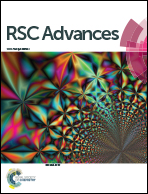1D nanorod-like porous carbon with simultaneous high energy and large power density as a supercapacitor electrode material
Abstract
A kind of 1D nanorod-like porous carbon PCPAC-2 with a length of about 0.5–2 μm and width of around 100–300 nm was synthesized by pyrolysis of a porous coordination polymer as a carbon source and structure template followed by KOH activation. The PCPAC-2 possesses a high specific BET surface of about 679 m2 g−1 and a total pore volume of 1.63 cm3 g−1. When serving as a supercapacitor electrode active material, the highest specific capacitance of 306 F g−1 was obtained at 1 A g−1. The specific capacitance of 205 F g−1 could be preserved at the large current density of 30 A g−1. The high cyclic stability with 96% capacitance retention was obtained after 5000 charge–discharge cycles at 1 A g−1. Moreover, the maximum energy density of 17.6 W h kg−1 could be found at the power density of 272.2 W kg−1, and the energy density of 10 W h kg−1 could be obtained at the high power density of 7530 W kg−1 in 6 M KOH aqueous electrolyte.


 Please wait while we load your content...
Please wait while we load your content...